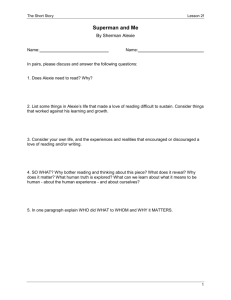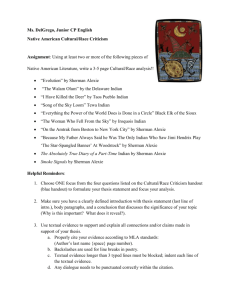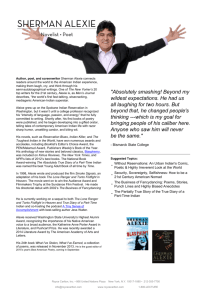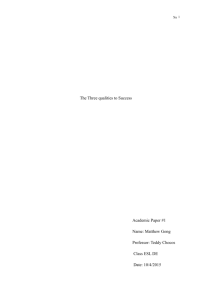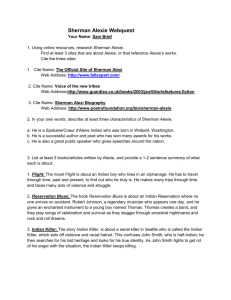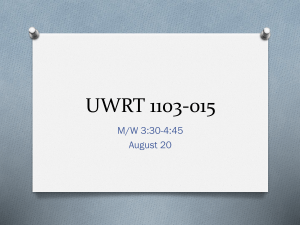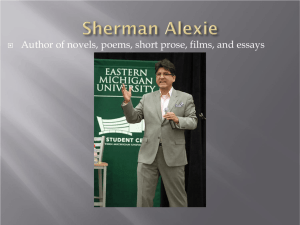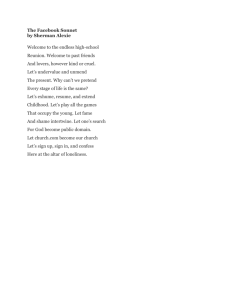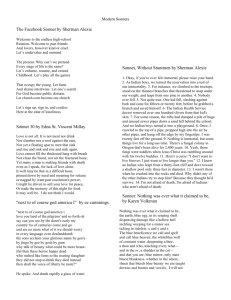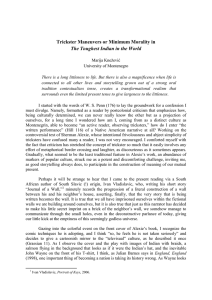ShermanAlexie(2)
advertisement
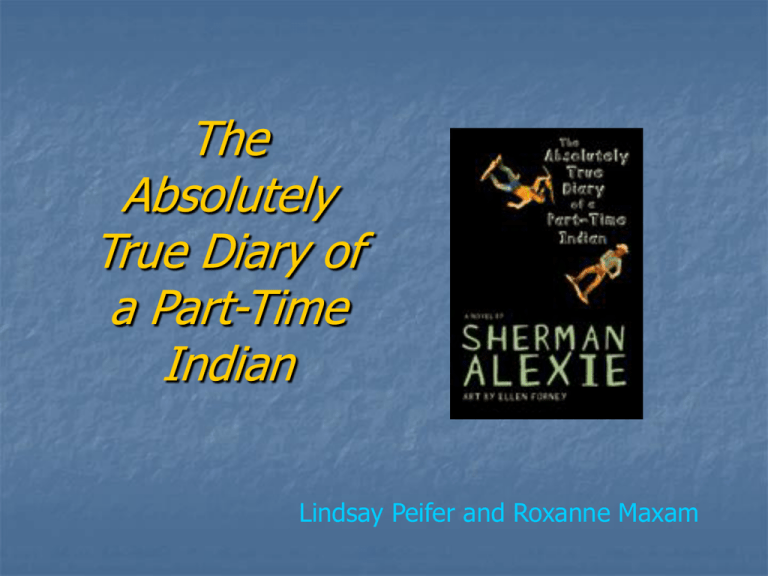
The Absolutely True Diary of a Part-Time Indian Lindsay Peifer and Roxanne Maxam Sherman Joseph Alexie, Jr. October 7, 1966- Biographical Info Spokane/Coeur d'Alene Born on Spokane Indian Reservation in Wellpinit, WA Born with hydrocephalus Suffered from seizures as a child Read Grapes of Wrath by age 5 Education Decided to transfer to Reardon when he saw his mother’s maiden name in his book at the reservation school Attended Gonzaga University on a scholarship Transferred to Washington State University Loves Wife, Diane Tomhave, who is of Hidatsa, Ho-Chunk and Potawatomi heritage Two sons: Joseph and David Basketball: playing and watching Prolific Author Novels, Poetry, Essays, Screenplays Alexie is currently working on his second young adult novel, Radioactive Love Song Official Sherman Alexie Website http://www.fallsapart.com/index.html Video of Alexie reading an excerpt from book: http://www.youtube.com/watch?v=NwiQb8OQ6dY Illustrator Ellen Forney Official Website: http://ellenforney.com/index.html American Indian Literature Notes from a Carol Miller lecture American Indian Literary Tradition: Importance of Literature For native people: Tool to ensure survival The power of self-representation: telling our own stories, speaking for ourselves Combat the “new native” stereotype Oral, and not print narratives, grounded in functionality, usefulness, and ACTIVISM Problematic Identity Reiterates issues of “victim-hood” and “doomed Indianness” Look to cultural continuance and activism instead Example: In Ceremony: Tayo’s rejection of internalized guilt and reintegrated into community Converging Themes Rejecting the ideology of the vanishing Indian and internalized guilt Examples: Fleur in Tracks, Solar Storms, Ceremony, Lone Ranger and Tonto Fistfight in Heaven. Emphasis upon individual in relation to community, rather than the personal Example: Deloria’s “scheme of life that worked” More Converging Themes Rejecting dysfunctional contemporary American Indian lives, emphasizing the importance of cultural continuance, and asserting Native sovereignty Focus on the exceptional individual as hero, selfreliance, Huck Finn—versus the community as central to the telling in American Indian literature, the disintegration and the restoration of community, de-center the notion of individual Why do American Indians need to tell the story? We are all under the sacred hoop, but so much silencing and damage has been done so it is very important for the inside voice to be heard, principal truths about recovery, authenticity, hard work, one needs to be culturally informed, indigenous aesthetics discovered by listening to what American Indians say about indigenous aesthetics, we are only explorers in this cultural terrain—go against the terrible history of actions placed upon American Indians Why do Native writers confirm the bad things people say about American Indians? Native writers would be remiss by turning a blind eye to the 500 years of colonial power, naïve to ignore the problems that have occurred in the community, careful reading explains or mediates those scenes; they are writing about those things to explain and understand the motivation of a Native person, by end of story there is a turn away from dark realities to a more hopeful outcome, community is putting itself back together, Native people get to talk about these things because they would be irresponsible not to. Resources Teaching Alexie Teacher Discussion Group: http://groups.yahoo.com/group/teaching_alexie/ Discussion of the book being banned: http://groups.yahoo.com/group/teaching_alexie/ message/29 Book was banned in Crook County, Oregon because it was deemed as inappropriate for 14-year olds to read. Reviews Powell’s Book Review: http://www.powells.com/biblio/9780316013680 School Library Journal review: http://www.schoollibraryjournal.com/blog/1790000379/post/8 50019885.html NPR review: http://www.npr.org/templates/story/story.php?storyId=14871 881 NYTimes Book Review: http://www.nytimes.com/2007/11/11/books/review/Barcott3t.html Suggested Reading Night Flying Woman: An Ojibway Narrative by Ignatia Broker Ceremony by Leslie Marmon Silko Love Medicine by Louise Erdrich Green Grass, Running Water by Thomas King Morning Girl by Michael Dorris Miko Kings: An Indian Baseball Story by LeAnne Howe Red Earth: A Vietnam warrior’s journey by Philip H. Red Eagle Helpful Resources American Indian Quarterly Studies in American Literature (SAIL) Wicazo sa (Red Pencil Journal) Discussion
